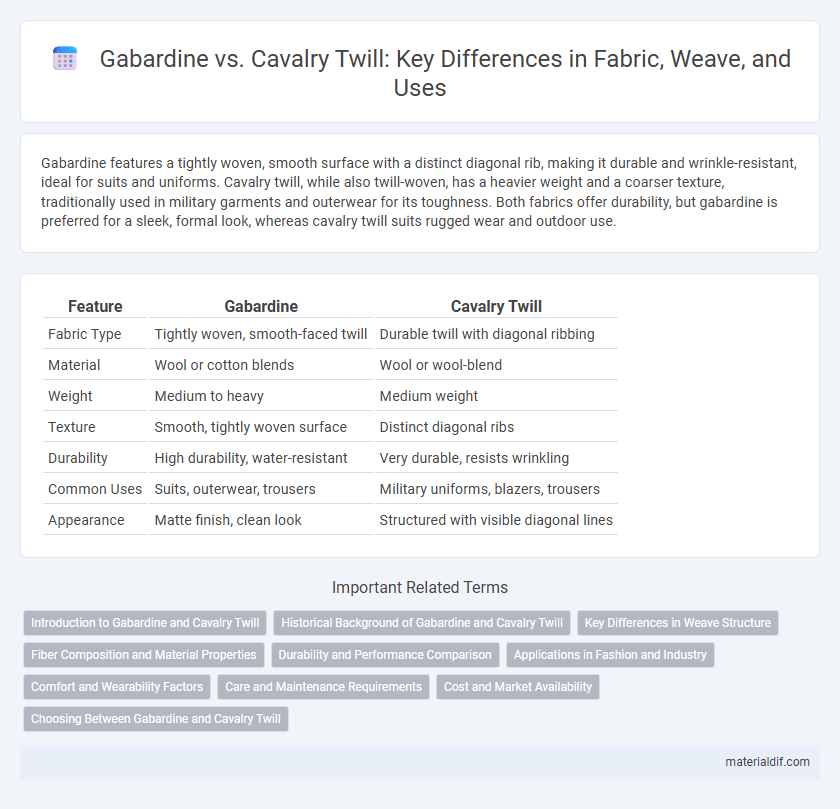Gabardine features a tightly woven, smooth surface with a distinct diagonal rib, making it durable and wrinkle-resistant, ideal for suits and uniforms. Cavalry twill, while also twill-woven, has a heavier weight and a coarser texture, traditionally used in military garments and outerwear for its toughness. Both fabrics offer durability, but gabardine is preferred for a sleek, formal look, whereas cavalry twill suits rugged wear and outdoor use.
Table of Comparison
| Feature | Gabardine | Cavalry Twill |
|---|---|---|
| Fabric Type | Tightly woven, smooth-faced twill | Durable twill with diagonal ribbing |
| Material | Wool or cotton blends | Wool or wool-blend |
| Weight | Medium to heavy | Medium weight |
| Texture | Smooth, tightly woven surface | Distinct diagonal ribs |
| Durability | High durability, water-resistant | Very durable, resists wrinkling |
| Common Uses | Suits, outerwear, trousers | Military uniforms, blazers, trousers |
| Appearance | Matte finish, clean look | Structured with visible diagonal lines |
Introduction to Gabardine and Cavalry Twill
Gabardine is a tightly woven, durable fabric often made from wool, characterized by its smooth finish and diagonal ribbing, ideal for suits and outerwear. Cavalry twill, originating from military uniforms, features a distinct, heavy twill weave with pronounced ridges, providing extra strength and resistance to wear. Both fabrics are prized for their sturdy construction and classic appearance, with gabardine offering a finer texture and cavalry twill emphasizing rugged durability.
Historical Background of Gabardine and Cavalry Twill
Gabardine originated in the late 19th century, invented by Thomas Burberry, who designed it as a tightly woven, water-resistant fabric ideal for outdoor wear. Cavalry twill has military roots dating back to British cavalry uniforms in the 19th century, characterized by its durable twill weave and distinct diagonal rib pattern used for heavy-duty clothing. Both fabrics share origins in functional, performance-driven applications but diverged in usage with gabardine becoming popular in civilian fashion and cavalry twill remaining tied to military and formal uniforms.
Key Differences in Weave Structure
Gabardine features a tightly woven twill weave with diagonal ribs running one direction, resulting in a smooth, durable fabric ideal for suits and uniforms. Cavalry twill has a more pronounced double twill weave with parallel ribs typically running across the fabric, providing extra texture and strength often used in military garments and outerwear. The key difference lies in gabardine's single twill diagonal pattern versus cavalry twill's double twill ribs, affecting both appearance and fabric performance.
Fiber Composition and Material Properties
Gabardine and Cavalry Twill differ primarily in fiber composition and material properties, with Gabardine commonly made from 100% wool or wool blends, offering a tightly woven, smooth texture that enhances durability and water resistance. Cavalry Twill is traditionally woven from heavier wool or cotton fibers, characterized by a more pronounced twill weave that provides greater strength and a slightly coarser handfeel. Both fabrics excel in durability and wrinkle resistance, but Gabardine's finer fiber alignment results in a sleeker, more breathable fabric compared to the robust, textured Cavalry Twill.
Durability and Performance Comparison
Gabardine is a tightly woven fabric with a smooth finish, known for its exceptional durability and resistance to wrinkles, making it ideal for uniforms and suits that require long-lasting wear. Cavalry twill, characterized by its distinct diagonal rib pattern, offers enhanced strength and abrasion resistance, often favored in outerwear and military garments for superior performance in rugged conditions. Both fabrics provide excellent durability, but gabardine excels in wrinkle resistance while cavalry twill delivers better abrasion resistance and structural stability.
Applications in Fashion and Industry
Gabardine, known for its tightly woven, durable twill weave, is extensively used in high-end fashion for tailored suits, trousers, and outerwear due to its smooth finish and water-resistant properties. Cavalry twill features a distinct ridge and heavier weight, making it ideal for military uniforms, workwear, and structured garments that require durability and a rugged appearance. Both fabrics are favored in industrial applications, but gabardine's finer texture suits refined apparel, whereas cavalry twill excels in heavy-duty, utilitarian clothing.
Comfort and Wearability Factors
Gabardine fabric, known for its tight weave and smooth finish, offers superior breathability and a lighter feel, enhancing comfort during prolonged wear. Cavalry twill features a more pronounced ribbed texture and heavier weight, providing greater durability but slightly reduced softness against the skin. For wearability, gabardine's flexibility suits warmer climates, whereas cavalry twill's robust structure excels in cooler environments and heavy-duty use.
Care and Maintenance Requirements
Gabardine requires gentle care with cold water washing and air drying to maintain its smooth finish and prevent shrinkage, while Cavalry Twill benefits from more robust care, including warm water washing and occasional ironing to preserve its durability and crisp texture. Both fabrics should avoid bleach and harsh detergents to retain color and fiber strength. Proper storage in a cool, dry place minimizes fabric wear and extends the lifespan of Gabardine and Cavalry Twill garments.
Cost and Market Availability
Gabardine fabric generally commands a higher price due to its tightly woven construction and premium wool content, making it a preferred choice for high-end garments in fashion markets. Cavalry twill is more affordable and widely available, often produced from a blend of wool and synthetic fibers, which enhances its accessibility in both mass-market and uniform sectors. The cost difference stems from production techniques and material quality, influencing their respective market presence and consumer demand.
Choosing Between Gabardine and Cavalry Twill
Gabardine offers a tightly woven, smooth surface with a slight diagonal rib, making it ideal for lightweight suits and uniforms requiring durability and breathability. Cavalry twill features a more pronounced diagonal weave, providing enhanced texture and greater weight, suitable for outerwear and military-inspired garments demanding toughness and structure. Selecting between gabardine and cavalry twill depends on the desired balance of fabric weight, texture, and functional use, with gabardine favoring refinement and cavalry twill emphasizing robustness.
Gabardine vs Cavalry Twill Infographic

 materialdif.com
materialdif.com